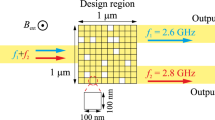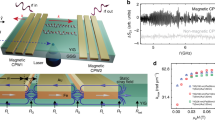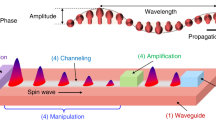Abstract
Magnons, the quanta of spin waves, could be used to encode information in beyond-Moore computing applications, and magnonic device components, including logic gates, transistors and units for non-Boolean computing, have already been developed. Magnonic directional couplers, which can function as circuit building blocks, have also been explored, but have been impractical because of their millimetre dimensions and multimode spectra. Here, we report a magnonic directional coupler based on yttrium iron garnet that has submicrometre dimensions. The coupler consists of single-mode waveguides with a width of 350 nm. We use the amplitude of a spin wave to encode information and to guide it to one of the two outputs of the coupler depending on the signal magnitude, frequency and the applied magnetic field. Using micromagnetic simulations, we also propose an integrated magnonic half-adder that consists of two directional couplers and we investigate its functionality for information processing within the magnon domain. The proposed half-adder is estimated to consume energy in the order of attojoules.
This is a preview of subscription content, access via your institution
Access options
Access Nature and 54 other Nature Portfolio journals
Get Nature+, our best-value online-access subscription
$29.99 / 30 days
cancel any time
Subscribe to this journal
Receive 12 digital issues and online access to articles
$119.00 per year
only $9.92 per issue
Buy this article
- Purchase on Springer Link
- Instant access to full article PDF
Prices may be subject to local taxes which are calculated during checkout





Similar content being viewed by others
Data availability
The data that support the plots within this paper and other findings of this study are available from the corresponding author upon reasonable request.
References
Kruglyak, V. V., Demokritov, S. O. & Grundler, D. Magnonics. J. Phys. D 43, 264001 (2010).
Lenk, B. et al. The building blocks of magnonics. Phys. Rep. 507, 107–136 (2011).
Krawczyk, M. & Grundler, D. Review and prospects of magnonic crystals and devices with reprogrammable band structure. J. Phys. Cond. Matter 26, 123202 (2014).
Chumak, A. V. et al. Magnon spintronics. Nat. Phys. 11, 453–461 (2015).
Dieny, B. et al. Opportunities and challenges for spintronics in the microelectronics industry. Nat. Electron. 3, 446–459 (2020).
Dubs, C. et al. Sub-micrometer yttrium iron garnet LPE films with low ferromagnetic resonance losses. J. Phys. D 50, 204005 (2017).
Dubs, C. et al. Low damping and microstructural perfection of sub-40-nm-thin yttrium iron garnet films grown by liquid phase epitaxy. Phys. Rev. Mater. 4, 024426 (2020).
Chumak, A. V., Serga, A. A. & Hillebrands, B. Magnon transistor for all-magnon data processing. Nat. Commun. 5, 4700 (2014).
Krivosik, P. & Patton, C. E. Hamiltonian formulation of nonlinear spin-wave dynamics: theory and applications. Phys. Rev. B 82, 184428 (2010).
Sadovnikov, A. V. et al. Nonlinear spin wave coupling in adjacent magnonic crystals. Appl. Phys. Lett. 109, 042407 (2016).
Khitun, A., Bao, M. & Wang, K. L. Magnonic logic circuits. J. Phys. D 43, 264005 (2010).
Manipatruni, S., Nikonov, D. E. & Young, I. A. Beyond CMOS computing with spin and polarization. Nat. Phys. 14, 338–343 (2018).
Zografos, O. et al. Design and benchmarking of hybrid CMOS-spin wave device circuits compared to 10-nm CMOS. In Proceedings of the 15th IEEE International Conference on Nanotechnology 686–689 (IEEE, 2015).
Duan, Z. et al. Nanowire spin torque oscillator driven by spin–orbit torques. Nat. Commun. 5, 5616 (2014).
Wang, Q. et al. Spin pinning and spin-wave dispersion in nanoscopic ferromagnetic waveguides. Phys. Rev. Lett. 122, 247202 (2019).
Wintz, S. et al. Magnetic vortex cores as tuneable spin-wave emitters. Nat. Nanotechnol. 11, 948–953 (2016).
Liu, C. et al. Current-controlled propagation of spin waves in antiparallel, coupled domains. Nat. Nanotechnol. 14, 691–697 (2019).
Che, P. et al. Efficient wavelength conversion of exchange magnons below 100 nm by magnetic coplanar waveguides. Nat. Commun. 11, 1445 (2020).
Wang, Q. et al. Reconfigurable nanoscale spin-wave directional coupler. Sci. Adv. 4, e1701517 (2018).
Kirilyuk, A., Kimel, A. V. & Rasing, T. Ultrafast optical manipulation of magnetic order. Rev. Mod. Phys. 82, 2731 (2010).
Kampfrath, T. et al. Coherent terahertz control of antiferromagnetic spin waves. Nat. Photon. 5, 31–34 (2011).
Lee, K.-S. & Kim, S.-K. Conceptual design of spin wave logic gates based on a Mach–Zehnder-type spin wave interferometer for universal logic functions. J. Appl. Phys. 104, 053903 (2008).
Schneider, T., Serga, A. A. & Hillebrands, B. Realization of spin-wave logic gate. Appl. Phys. Lett. 92, 022505 (2008).
Goto, T. et al. Three port logic gate using forward volume spin wave interference in a thin yttrium iron garnet film. Sci. Rep. 9, 16472 (2019).
Khivintsev, Y. V. et al. Spin waves in YIG-based networks: logic and signal processing. Phys. Metals Metallogr. 120, 1318–1324 (2019).
Fischer, T. et al. Experimental prototype of a spin-wave majority gate. Appl. Phys. Lett. 110, 152401 (2017).
Talmelli, G. et al. Reconfigurable nanoscale spin wave majority gate with frequency-division multiplexing. Preprint at https://arxiv.org/pdf/1908.02546.pdf (2019).
Wu, H. et al. Magnon valve effect between two magnetic insulators. Phys. Rev. Lett. 120, 097205 (2018).
Vogt, K. et al. Realization of a spin-wave multiplexer. Nat. Commun. 5, 3727 (2014).
Heussner, F. et al. Experimental realization of a passive gigahertz frequency‐division demultiplexer for magnonic logic networks. Phys. Status Solidi 14, 1900695 (2020).
Papp, A. et al. Nanoscale spectrum analyzer based on spin-wave interference. Sci. Rep. 7, 9245 (2017).
Torrejon, J. et al. Neuromorphic computing with nanoscale spintronic oscillators. Nature 547, 428–431 (2017).
Brächer, T. & Pirro, P. An analog magnon adder for all-magnonic neurons. J. Appl. Phys. 124, 152119 (2018).
Chumak, A. V. in Spintronics Handbook: Spin Transport and Magnetism (eds Tsymbal, E. Y. & Žutić, I.) 247–303 (Taylor & Francis, 2019).
Sadovnikov, A. V. et al. Directional multimode coupler for planar magnonics: side-coupled magnetic stripes. Appl. Phys. Lett. 107, 202405 (2015).
Sebastian, T. et al. Micro-focused Brillouin light scattering: imaging spin waves at the nanoscale. Front. Phys. 3, 35 (2015).
Heinz, B. et al. Propagation of spin-wave packets in individual nanosized yttrium iron garnet magnonic conduits. Nano Lett. 20, 4220–4227 (2020).
Clausen, P. et al. Mode conversion by symmetry breaking of propagating spin waves. Appl. Phys. Lett. 99, 162505 (2011).
Brächer, T., Pirro, P. & Hillebrands, B. Parallel pumping for magnon spintronics: amplification and manipulation of magnon spin currents on the micron-scale. Phys. Rep. 699, 1–34 (2017).
Verba, R. et al. Amplification and stabilization of large-amplitude propagating spin waves by parametric pumping. Appl. Phys. Lett. 112, 042402 (2018).
Mohseni, M. et al. Parametric generation of propagating spin waves in ultrathin yttrium iron garnet waveguides. Phys. Status Solidi RRL 14, 2000011 (2020).
Imre, A. et al. Majority logic gate for magnetic quantum-dot cellular automata. Science 311, 205–208 (2006).
Verba, R. et al. Excitation of propagating spin waves in ferromagnetic nanowires by microwave voltage-controlled magnetic anisotropy. Sci. Rep. 6, 25018 (2016).
Schneider, M. et al. Bose–Einstein condensation of quasi-particles by rapid cooling. Nat. Nanotechnol. 15, 457–461 (2020).
Bauer, H. G. et al. Nonlinear spin-wave excitations at low magnetic bias fields. Nat. Commun. 6, 8274 (2015).
Dobrovolskiy, O. V. et al. Spin-wave phase inverter upon a single nanodefect. ACS Appl. Mater. Interfaces 11, 17654–17662 (2019).
Chen, Y. et al. Parametric resonance of magnetization excited by electric field. Nano. Lett. 17, 572–577 (2017).
Sadovnikov, A. V. et al. Magnon straintronics: reconfigurable spin-wave routing in strain-controlled bilateral magnetic stripes. Phys. Rev. Lett. 120, 257203 (2018).
Guillemard, C. et al. Ultralow magnetic damping in Co2Mn-based Heusler compounds: promising materials for spintronics. Phys. Rev. Appl. 11, 064009 (2019).
Robertson, J. Liquid phase epitaxy of garnets. J. Cryst. Growth 45, 233–242 (1978).
Maksymov, I. S. & Kostylev, M. Broadband stripline ferromagnetic resonance spectroscopy of ferromagnetic films, multilayers and nanostructures. Physica E 69, 253–293 (2015).
Morozova, M. A. et al. Suppression of periodic spatial power transfer in a layered structure based on ferromagnetic films. J. Magn. Magn. Mater. 466, 119–124 (2018).
Vansteenkiste, A. et al. The design and verification of MuMax3. AIP Adv. 4, 107133 (2014).
Kumar, D. et al. Numerical calculation of spin wave dispersions in magnetic nanostructures. J. Phys. D 45, 015001 (2012).
Venkat, G., Fangohr, H. & Prabhakar, A. Absorbing boundary layers for spin wave micromagnetics. J. Magn. Magn. Mater. 450, 34–39 (2018).
Acknowledgements
We thank B. Hillebrands for support and valuable discussions. This research has been supported by ERC Starting Grant 678309 MagnonCircuits, FET-OPEN project CHIRON (contract no. 801055), the Deutsche Forschungsgemeinschaft (DFG, German Research Foundation) TRR-173 – 268565370 (Collaborative Research Center SFB/TRR-173 ‘Spin+X’, project B01) and DFG project no. 271741898, the Austrian Science Fund (FWF) through project I 4696-N and the Ministry of Education and Science of Ukraine, project 0118U004007. B.H. acknowledges support from the Graduate School Material Science in Mainz (MAINZ).
Author information
Authors and Affiliations
Contributions
Q.W. proposed the directional coupler and half-adder design, preformed the BLS measurements, carried out the evaluation and wrote the first version of the manuscript. C.D. provided the YIG film. M.K., B.H. and B.L. fabricated the nanoscale directional coupler. M.S., B.H. and M.G developed the BLS set-up. T.B. acquired the SEM micrograph. M.K. performed the VNA-FMR measurements. R.V. developed the analytical theory and performed the theoretical calculations. Q.W. and M.M. performed the micromagnetic simulations. F.C., C.A. and S.D.C. performed the benchmarking and calculated the parameters of the 7-nm CMOS half-adder. O.V.D. and T.B. discussed the interpretation and the relevance of the results. P.P. and A.V.C. led this project. All authors contributed to the scientific discussion and commented on the manuscript.
Corresponding authors
Ethics declarations
Competing interests
The authors declare no competing interests.
Additional information
Publisher’s note Springer Nature remains neutral with regard to jurisdictional claims in published maps and institutional affiliations.
Extended data
Extended Data Fig. 1 Effect of far-field excitation by the U-shaped antenna.
SEM images of the a normal and b displaced waveguides. The red and blue dots show the μBLS measurement points. c, The spin-wave intensities for normal (red dot line), displaced waveguides (blue dot line) and thermal background (black dot line). The grey area shows the working frequency range in the paper.
Extended Data Fig. 2 Spin-wave spectra in the isolated waveguide.
a, The in-plane (black line) and out-of-plane (red line) field distribution created by the U-shape antenna. The schematic cross section of a U-shaped antenna is shown inset. b, The excitation efficiency as a function of spin-wave wavenumber. c, Spin-wave frequency as a function of spin-wave wavenumber. d, Spin-wave intensities are measured 4 μm far from the antenna for different excitation powers. The black line shows the analytical calculation of the spin-wave intensity. A SEM image of the isolated waveguide is shown on the top of Fig. 2d.
Extended Data Fig. 3 Reconfigurability of the directional coupler by an applied magnetic field.
a, The averaged spin-wave intensity for a frequency of 3.465 GHz as function of the external field for the first (blue circles) and the second (red squares) output waveguide of the directional coupler. b, Measured (circles and squares) and theoretically calculated (solid lines) normalized output spin-wave intensities at the first (blue) and second (red) output waveguide for different external fields. c–e, Two-dimensional BLS maps of the spin-wave intensity for the different external magnetic fields: c, B1 = 56 mT, d. B2 = 53.2 mT, and e. B3 = 51.3 mT. The right panels show the BLS intensity integrated over the red dashed rectangular regions.
Extended Data Fig. 4 Modified half-adder with fan-out gate.
a-c, Operational principle and d truth table of two half-adders with shared inputs (corresponds to the half-adder with added fan-out logic gate).
Extended Data Fig. 5 Parametric amplification.
a, A schematic picture of the parametric amplifier. b, Output spin-wave intensity as a function of pumping current for different conditions.
Supplementary information
Supplementary Information
Supplementary Discussion, Figs. 1–5 and Table 1.
Rights and permissions
About this article
Cite this article
Wang, Q., Kewenig, M., Schneider, M. et al. A magnonic directional coupler for integrated magnonic half-adders. Nat Electron 3, 765–774 (2020). https://doi.org/10.1038/s41928-020-00485-6
Received:
Accepted:
Published:
Issue Date:
DOI: https://doi.org/10.1038/s41928-020-00485-6
This article is cited by
-
Three-dimensional spin-wave dynamics, localization and interference in a synthetic antiferromagnet
Nature Communications (2024)
-
True amplification of spin waves in magnonic nano-waveguides
Nature Communications (2024)
-
Observing high-k magnons with Mie-resonance-enhanced Brillouin light scattering
Communications Physics (2023)
-
A spinwave Ising machine
Communications Physics (2023)
-
Tailoring crosstalk between localized 1D spin-wave nanochannels using focused ion beams
Scientific Reports (2023)



